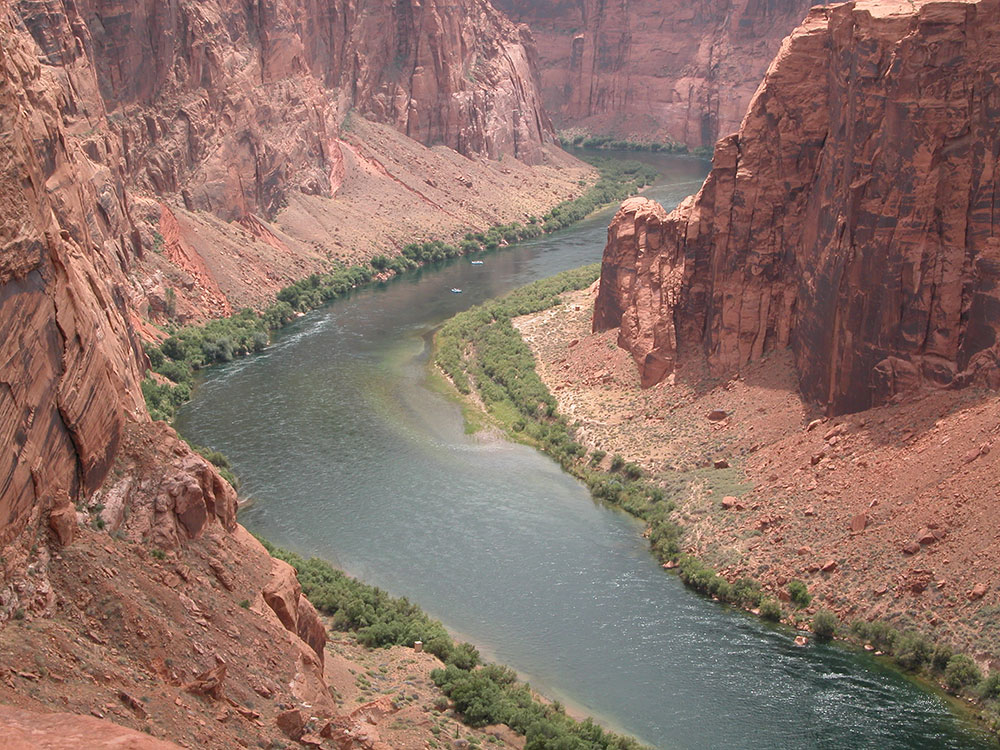- Reclamation
- News & Multimedia
- News Releases
- News Release Archive
- Second Bug Flow experiment to be conducted under the Glen Canyon Dam Long-Term Experimental and Management Plan
News Release Archive
Second Bug Flow experiment to be conducted under the Glen Canyon Dam Long-Term Experimental and Management Plan
Media Contact:
Marlon Duke, 801-524-3774, mduke@usbr.gov
Lee Traynham, 801-524-3752, ltraynham@usbr.gov
For Release: April 30, 2019

Colorado River down Lees FerrySALT LAKE CITY—The Department of the Interior will conduct a second Macroinvertebrate Production Flow this summer at Glen Canyon Dam under its Long-Term Experimental and Management Plan. This experiment, also known as a Bug Flow, aims to improve egg-laying conditions for aquatic insects that are the primary food source for fish in the Colorado River. The experiment will begin on May 1 and continue through August 31, 2019.
“Last year’s experiment was a big success, so we’re excited that a second year of testing will occur,” said Scott VanderKooi, Chief of the U.S. Geological Survey’s Grand Canyon Monitoring and Research Center, which monitors Colorado River ecosystem response to all Glen Canyon Dam flow experiments. “By directly experimenting with flows, we were able to learn a lot about the aquatic ecosystem in Grand Canyon. More importantly, preliminary results show that many different resources may have benefitted from last year’s experimental flows.”
This year’s Bug Flows will slightly modify release schedules and flow rates from Lake Powell through Glen Canyon Dam, but will not affect total annual, monthly or weekly release volumes. Flows during the experiment will include relatively low, steady weekend water releases while maintaining routine hydropower production flows on weekdays. Weekday flows will be higher than normal, but hourly changes in release rates will remain unchanged. Steady weekend flows are expected to provide favorable conditions for aquatic insects to lay and cement their eggs to rocks, vegetation and other materials near the river’s edge at a low enough level that the eggs will not dry out as flows fluctuate during the week. Casual recreational river users are unlikely to notice the changes in water levels.
Preliminary findings show that caddisflies, an aquatic insect that has been extremely rare in the Grand Canyon over the past several decades, increased nearly four-fold during last year’s Bug Flow experiment. Non-biting midges, another type of aquatic insect that is a key food source for fish and other wildlife, were up to 800% more abundant on weekends when flows were steady compared to weekdays when flows fluctuated for hydropower production. Data collected by the Arizona Game and Fish Department showed that fishing also improved, with the average angler catching around 18% more rainbow trout at Lees Ferry during weekend steady flows compared to weekdays when flows fluctuated.
The decision to conduct this experiment was based on input from a collaborative team, including the Department of the Interior’s Bureau of Reclamation, National Park Service, U.S. Geological Survey, U.S. Fish and Wildlife Service, and Bureau of Indian Affairs; the Department of Energy’s Western Area Power Administration; the Arizona Game and Fish Department, Upper Colorado River Commission and all seven of the Colorado River Basin States. Experiments are designed to optimize benefits to the Colorado River ecosystem through the Grand Canyon while meeting water delivery requirements and minimizing negative impacts to hydropower production.
Insects expected to benefit from this experiment are an important food source for many species of fish, birds, and bats in the canyon. Beyond expected resource benefits, this experiment will also provide scientific information that will be used in future decision making.
# # #
The Bureau of Reclamation is a federal agency under the U.S. Department of the Interior and is the nation's largest wholesale water supplier and second largest producer of hydroelectric power. Our facilities also provide substantial flood control, recreation opportunities, and environmental benefits. Visit our website at https://www.usbr.gov and follow us on Twitter @USBR; Facebook @bureau.of.reclamation; LinkedIn @Bureau of Reclamation; Instagram @bureau_of_reclamation; and YouTube @reclamation.
Relevant Link:
Lake Powell 40-day data (elevation, storage, inflows, and releases)

